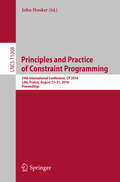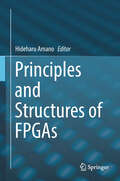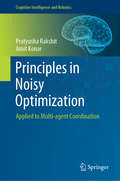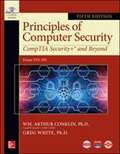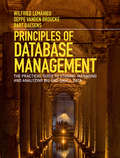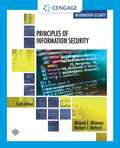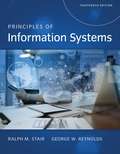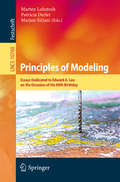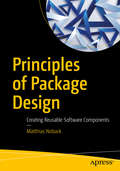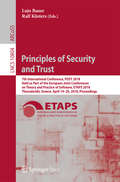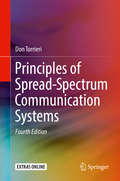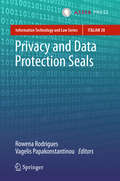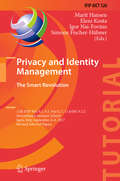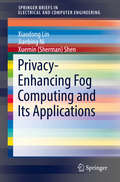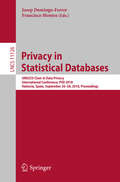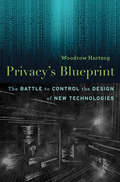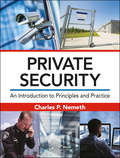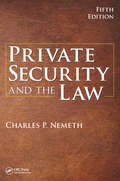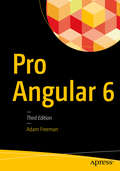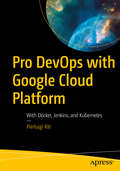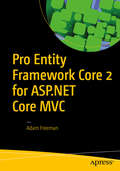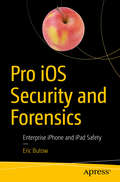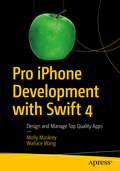- Table View
- List View
PRINCE2 Study Guide: 2017 Update
by David HindeEverything you need to pass the PRINCE2 with flying colors The PRINCE2 Study Guide, Second Edition, offers comprehensive preparation for the latest PRINCE2 exam. Covering 100 percent of the exam objectives, this guide provides invaluable guidance that will help you master both the material and its applications; indeed, a practice-centered approach helps you “learn by doing” to help you internalize PRINCE2 concepts on a deeper level. Although the exam is heavily focused on detailed business process, this guide’s accessible writing and real-world approach make learning fun. Each chapter poses a common project challenge, and walks you through the solution based on essential PRINCE2 principles. A year of FREE access to electronic study aids allows you to study anywhere, at any time, and expert instruction throughout breaks complex topics down into easily-digestible concepts. The PRINCE2 exam is challenging, but thorough preparation is your best defense. Conceptual knowledge is important, but it isn’t enough—knowledge is only useful if you can apply it. This book is designed as your personal PRINCE2 coach: Master 100 percent of the PRINCE2 exam objectives Apply your knowledge to real-world workplace scenarios Test your understanding with challenging review questions Access sample questions, electronic flashcards, and other study aids PRINCE2 is globally recognized as one of the premier project management credentials; while less expansive than the PMP, the PRINCE2 is more intense and tightly focused on detailed business processes. Companies around the world are in need of qualified project management professionals to optimize processes and boost organizational performance—and the PRINCE2 certification puts you on the map as a validated professional. If you’re ready to take on your next challenge, the PRINCE2 Study Guide, Second Edition, is your ultimate companion for complete preparation.
Principles and Practice of Constraint Programming: 24th International Conference, Cp 2018, Lille, France, August 27-31, 2018, Proceedings (Lecture Notes in Computer Science #11008)
by John HookerThis book constitutes the proceedings of the 24th International Conference on Principles and Practice of Constraint Programming, CP 2018, held in Lille, France, in August 2018.The 41 full and 9 short papers presented in this volume were carefully reviewed and selected from 114 submissions. They deal with all aspects of computing with constraints including theory, algorithms, environments, languages, models, systems, and applications such as decision making, resource allocation, scheduling, configuration, and planning. The papers were organized according to the following topics/tracks: main technical track; applications track; CP and data science; CP and music; CP and operations research; CP, optimization and power system management; multiagent and parallel CP; and testing and verification.
Principles and Structures of FPGAs
by Hideharu AmanoThis comprehensive textbook on the field programmable gate array (FPGA) covers its history, fundamental knowledge, architectures, device technologies, computer-aided design technologies, design tools, examples of application, and future trends. Programmable logic devices represented by FPGAs have been rapidly developed in recent years and have become key electronic devices used in most IT products. This book provides both complete introductions suitable for students and beginners, and high-level techniques useful for engineers and researchers in this field. Differently developed from usual integrated circuits, the FPGA has unique structures, design methodologies, and application techniques. Allowing programming by users, the device can dramatically reduce the rising cost of development in advanced semiconductor chips. The FPGA is now driving the most advanced semiconductor processes and is an all-in-one platform combining memory, CPUs, and various peripheral interfaces. This book introduces the FPGA from various aspects for readers of different levels. Novice learners can acquire a fundamental knowledge of the FPGA, including its history, from Chapter 1; the first half of Chapter 2; and Chapter 4. Professionals who are already familiar with the device will gain a deeper understanding of the structures and design methodologies from Chapters 3 and 5. Chapters 6–8 also provide advanced techniques and cutting-edge applications and trends useful for professionals. Although the first parts are mainly suitable for students, the advanced sections of the book will be valuable for professionals in acquiring an in-depth understanding of the FPGA to maximize the performance of the device.
Principles in Noisy Optimization: Applied to Multi-agent Coordination (Cognitive Intelligence and Robotics)
by Pratyusha Rakshit Amit KonarNoisy optimization is a topic of growing interest for researchers working on mainstream optimization problems. Although several techniques for dealing with stochastic noise in optimization problems are covered in journals and conference proceedings, today there are virtually no books that approach noisy optimization from a layman’s perspective; this book remedies that gap. Beginning with the foundations of evolutionary optimization, the book subsequently explores the principles of noisy optimization in single and multi-objective settings, and presents detailed illustrations of the principles developed for application in real-world multi-agent coordination problems. Special emphasis is given to the design of intelligent algorithms for noisy optimization in real-time applications. The book is unique in terms of its content, writing style and above all its simplicity, which will appeal to readers with a broad range of backgrounds.The book is divided into 7 chapters, the first of which provides an introduction to Swarm and Evolutionary Optimization algorithms. Chapter 2 includes a thorough review of agent architectures for multi-agent coordination. In turn, Chapter 3 provides an extensive review of noisy optimization, while Chapter 4 addresses issues of noise handling in the context of single-objective optimization problems. An illustrative case study on multi-robot path-planning in the presence of measurement noise is also highlighted in this chapter. Chapter 5 deals with noisy multi-objective optimization and includes a case study on noisy multi-robot box-pushing. In Chapter 6, the authors examine the scope of various algorithms in noisy optimization problems. Lastly, Chapter 7 summarizes the main results obtained in the previous chapters and elaborates on the book’s potential with regard to real-world noisy optimization problems.
Principles of Computer Security: Comp TIA Security and Beyond
by Gregory White Chuck Cothren Roger Davis Dwayne Williams Wm. ConklinLearn IT security fundamentals while getting complete coverage of the objectives for the latest release of CompTIA Security+ certification exam SY0-501. This thoroughly revised, full-color textbook discusses communication, infrastructure, operational security, attack prevention, disaster recovery, computer forensics, and much more. Written by a pair of highly respected security educators, Principles of Computer Security: CompTIA Security+® and Beyond, Fifth Edition (Exam SY0-501) will help you pass the exam and become a CompTIA certified computer security expert.
Principles of Database Management: The Practical Guide to Storing, Managing and Analyzing Big and Small Data
by Wilfried Lemahieu Seppe Vanden Broucke Bart BaesensThis comprehensive textbook teaches the fundamentals of database design, modeling, systems, data storage, and the evolving world of data warehousing, governance and more. Written by experienced educators and experts in big data, analytics, data quality, and data integration, it provides an up-to-date approach to database management. This full-color, illustrated text has a balanced theory-practice focus, covering essential topics, from established database technologies to recent trends, like Big Data, NoSQL, and more. Fundamental concepts are supported by real-world examples, query and code walkthroughs, and figures, making it perfect for introductory courses for advanced undergraduates and graduate students in information systems or computer science. These examples are further supported by an online playground with multiple learning environments, including MySQL; MongoDB; Neo4j Cypher; and tree structure visualization. This combined learning approach connects key concepts throughout the text to the important, practical tools to get started in database management.
Principles of Information Security (MindTap Course List Series)
by Michael E. Whitman Herbert J. MattordPrinciples of Information Security, Sixth Edition, provides a broad review of the entire field of information security, background on many related elements, and enough detail to facilitate an understanding of the topic as a whole. The book covers the terminology of the field, the history of the discipline, and strategies for managing an information security program. You review terms used in the field and a history of the discipline as you learn how to manage an information security program. Current and relevant, this edition highlights the latest practices with fresh examples that explore the impact of emerging technologies, such as the Internet of Things, Cloud Computing, and DevOps. Updates address technical security controls, emerging legislative issues, digital forensics, and ethical issues in IS security, making this the ideal IS resource for business decision makers.
Principles Of Information Systems
by Ralph M. Stair George W. ReynoldsDevelop an understanding of the core principles of IS and how it is practiced today with PRINCIPLES OF INFORMATION SYSTEMS, 13th edition. This edition combines the latest research with the most current coverage available as content highlights IS-related careers. You explore the challenges and risks of computer crimes, hacking, and cyberterrorism as well as the most current research on big data, analytics, and global IS and social networking. In addition, you examine business intelligence, cloud computing, e-commerce, enterprise systems, mobile computing, strategic planning, and systems acquisition. You learn how information systems can increase profits and reduce costs as you explore artificial intelligence, change management, data governance, environmental concerns, Internet of Everything, Internet censorship and net neutrality, virtual teams, and more. Interactive multimedia resources, MindTap, help you maximize success as an employee, decision maker, and business leader.
Principles of Modeling: Essays Dedicated to Edward A. Lee on the Occasion of His 60th Birthday (Lecture Notes in Computer Science #10760)
by Marten Lohstroh Patricia Derler Marjan SirjaniThis Festschrift is published in honor of Edward A. Lee, Robert S. Pepper Distinguished Professor Emeritus and Professor in the Graduate School in the Department of Electrical Engineering and Computer Sciences at the University of California, Berkeley, USA, on the occasion of his 60th birthday.The title of this Festschrift is “Principles of Modeling" because Edward A. Lee has long been devoted to research that centers on the role of models in science and engineering. He has been examining the use and limitations of models, their formal properties, their role in cognition and interplay with creativity, and their ability to represent reality and physics. The Festschrift contains 29 papers that feature the broad range of Edward A. Lee’s research topics; such as embedded systems; real-time computing; computer architecture; modeling and simulation, and systems design.
Principles of Package Design: Creating Reusable Software Components
by Matthias NobackApply design principles to your classes, preparing them for reuse. You will use package design principles to create packages that are just right in terms of cohesion and coupling, and are user- and maintainer-friendly at the same time.The first part of this book walks you through the five SOLID principles that will help you improve the design of your classes. The second part introduces you to the best practices of package design, and covers both package cohesion principles and package coupling principles. Cohesion principles show you which classes should be put together in a package, when to split packages, and if a combination of classes may be considered a "package" in the first place. Package coupling principles help you choose the right dependencies and prevent wrong directions in the dependency graph of your packages.What You'll LearnApply the SOLID principles of class designDetermine if classes belong in the same packageKnow whether it is safe for packages to depend on each otherWho This Book Is ForSoftware developers with a broad range of experience in the field, who are looking for ways to reuse,share, and distribute their code
Principles of Security and Trust: 7th International Conference, Post 2018, Held As Part Of The European Joint Conferences On Theory And Practice Of Software, Etaps 2018, Thessaloniki, Greece, April 14-20, 2018, Proceedings (Lecture Notes in Computer Science #10804)
by Lujo Bauer Ralf KüstersThis open access book constitutes the proceedings of the 7th International Conference on Principles of Security and Trust, POST 2018, which took place in Thessaloniki, Greece, in April 2018, held as part of the European Joint Conference on Theory and Practice of Software, ETAPS 2018. The 13 papers presented in this volume were carefully reviewed and selected from 45 submissions. The papers are organized in topical sections named: information flow and non-intereference; leakage, information flow, and protocols; smart contracts and privacy; firewalls and attack-defense trees.
Principles of Spread-Spectrum Communication Systems
by Don TorrieriThis thoroughly revised textbook provides the fundamentals of spread-spectrum systems with a continued emphasis on theoretical principles. The revision includes new sections and appendices on characteristic functions and LaPlace transforms, orthonormal expansions of functions, the SNR wall in detection, multiple-input multiple-output systems, multicode and multirate systems, interference cancelers, complementary codes, chaos and ultrawideband systems, and the normalized LMS algorithm. As with previous editions, the author presents topics in a practical way that is of interest to both researchers and system designers. He includes updated problems at the end of each chapter, which are intended to assist readers in consolidating their knowledge and to provide practice in analytical techniques. In addition to the new and revised material, the author adds 50 new pages to make the book more accessible to graduate students in electrical engineering.
Privacy and Data Protection Seals (Information Technology and Law Series #28)
by Rowena Rodrigues Vagelis PapakonstantinouThe book presents timely and needed contributions on privacy and data protection seals as seen from general, legal, policy, economic, technological, and societal perspectives. It covers data protection certification in the EU (i.e., the possibilities, actors and building blocks); the Schleswig-Holstein Data Protection Seal; the French Privacy Seal Scheme; privacy seals in the USA, Europe, Japan, Canada, India and Australia; controversies, challenges and lessons for privacy seals; the potential for privacy seals in emerging technologies; and an economic analysis. This book is particularly relevant in the EU context, given the General Data Protection Regulation (GDPR) impetus to data protection certification mechanisms and the dedication of specific provisions to certification. Its coverage of practices in jurisdictions outside the EU also makes it relevant globally. This book will appeal to European legislators and policy-makers, privacy and data protection practitioners, certification bodies, international organisations, and academics.Rowena Rodrigues is a Senior Research Analyst with Trilateral Research Ltd. in London and Vagelis Papakonstantinou is a Senior Researcher at the Vrije Universiteit Brussel in Brussels.
Privacy and Identity Management. The Smart Revolution: 12th IFIP WG 9.2, 9.5, 9.6/11.7, 11.6/SIG 9.2.2 International Summer School, Ispra, Italy, September 4-8, 2017, Revised Selected Papers (IFIP Advances in Information and Communication Technology #526)
by Eleni Kosta Simone Fischer-Hübner Marit Hansen Igor Nai-FovinoThis book contains selected papers presented at the 12th IFIP WG 9.2, 9.5, 9.6/11.7, 11.6/SIG 9.2.2 International Summer School on Privacy and Identity Management, held in Ispra, Italy, in September 2017.The 12 revised full papers, 5 invited papers and 4 workshop papers included in this volume were carefully selected from a total of 48 submissions and were subject to a three-phase review process. The papers combine interdisciplinary approaches to bring together a host of perspectives: technical, legal, regulatory, socio-economic, social, societal, political, ethical, anthropological, philosophical, and psychological. They are organized in the following topical sections: privacy engineering; privacy in the era of the smart revolution; improving privacy and security in the era of smart environments; safeguarding personal data and mitigating risks; assistive robots; and mobility and privacy.
Privacy as Trust: Information Privacy for an Information Age
by Ari Ezra WaldmanIt seems like there is no such thing as privacy anymore. But the truth is that privacy is in danger only because we think about it in narrow, limited, and outdated ways. In this transformative work, Ari Ezra Waldman, leveraging the notion that we share information with others in contexts of trust, offers a roadmap for data privacy that will better protect our information in a digitized world. With case studies involving websites, online harassment, intellectual property, and social robots, Waldman shows how 'privacy as trust' can be applied in the most challenging real-world contexts to make privacy work for all of us. This book should be read by anyone concerned with reshaping the theory and practice of privacy in the modern world.
Privacy-Enhancing Fog Computing and Its Applications (SpringerBriefs in Electrical and Computer Engineering)
by Xiaodong Lin Jianbing Ni Xuemin Sherman ShenThis SpringerBrief covers the security and privacy challenges in fog computing, and proposes a new secure and privacy-preserving mechanisms to resolve these challenges for securing fog-assisted IoT applications. Chapter 1 introduces the architecture of fog-assisted IoT applications and the security and privacy challenges in fog computing. Chapter 2 reviews several promising privacy-enhancing techniques and illustrates examples on how to leverage these techniques to enhance the privacy of users in fog computing. Specifically, the authors divide the existing privacy-enhancing techniques into three categories: identity-hidden techniques, location privacy protection and data privacy enhancing techniques. The research is of great importance since security and privacy problems faced by fog computing impede the healthy development of its enabled IoT applications. With the advanced privacy-enhancing techniques, the authors propose three secure and privacy-preserving protocols for fog computing applications, including smart parking navigation, mobile crowdsensing and smart grid. Chapter 3 introduces identity privacy leakage in smart parking navigation systems, and proposes a privacy-preserving smart parking navigation system to prevent identity privacy exposure and support efficient parking guidance retrieval through road-side units (fogs) with high retrieving probability and security guarantees. Chapter 4 presents the location privacy leakage, during task allocation in mobile crowdsensing, and propose a strong privacy-preserving task allocation scheme that enables location-based task allocation and reputation-based report selection without exposing knowledge about the location and reputation for participators in mobile crowdsensing. Chapter 5 introduces the data privacy leakage in smart grid, and proposes an efficient and privacy-preserving smart metering protocol to allow collectors (fogs) to achieve real-time measurement collection with privacy-enhanced data aggregation. Finally, conclusions and future research directions are given in Chapter 6. This brief validates the significant feature extension and efficiency improvement of IoT devices without sacrificing the security and privacy of users against dishonest fog nodes. It also provides valuable insights on the security and privacy protection for fog-enabled IoT applications. Researchers and professionals who carry out research on security and privacy in wireless communication will want to purchase this SpringerBrief. Also, advanced level students, whose main research area is mobile network security will also be interested in this SpringerBrief.
Privacy in Statistical Databases: UNESCO Chair in Data Privacy, International Conference, PSD 2018, Valencia, Spain, September 26–28, 2018, Proceedings (Lecture Notes in Computer Science #11126)
by Josep Domingo-Ferrer Francisco MontesThis book constitutes the refereed proceedings of the International Conference on Privacy in Statistical Databases, PSD 2018, held in Valencia, Spain, in September 2018 under the sponsorship of the UNESCO Chair in Data Privacy. The 23 revised full papers presented were carefully reviewed and selected from 42 submissions. The papers are organized into the following topics: tabular data protection; synthetic data; microdata and big data masking; record linkage; and spatial and mobility data.Chapter "SwapMob: Swapping Trajectories for Mobility Anonymization" is available open access under a Creative Commons Attribution 4.0 International License via link.springer.com.
Privacy’s Blueprint: The Battle to Control the Design of New Technologies
by Woodrow HartzogEvery day, Internet users interact with technologies designed to undermine their privacy. Social media apps, surveillance technologies, and the Internet of Things are all built in ways that make it hard to guard personal information. And the law says this is okay because it is up to users to protect themselves—even when the odds are deliberately stacked against them. In Privacy’s Blueprint, Woodrow Hartzog pushes back against this state of affairs, arguing that the law should require software and hardware makers to respect privacy in the design of their products. Current legal doctrine treats technology as though it were value-neutral: only the user decides whether it functions for good or ill. But this is not so. As Hartzog explains, popular digital tools are designed to expose people and manipulate users into disclosing personal information. Against the often self-serving optimism of Silicon Valley and the inertia of tech evangelism, Hartzog contends that privacy gains will come from better rules for products, not users. The current model of regulating use fosters exploitation. Privacy’s Blueprint aims to correct this by developing the theoretical underpinnings of a new kind of privacy law responsive to the way people actually perceive and use digital technologies. The law can demand encryption. It can prohibit malicious interfaces that deceive users and leave them vulnerable. It can require safeguards against abuses of biometric surveillance. It can, in short, make the technology itself worthy of our trust.
Private Security: An Introduction to Principles and Practice
by Charles P. NemethThere are few textbooks available that outline the foundation of security principles while reflecting the modern practices of private security as an industry. Private Security: An Introduction to Principles and Practice takes a new approach to the subject of private sector security that will be welcome addition to the field. The book focuses on the recent history of the industry and the growing dynamic between private sector security and public safety and law enforcement. Coverage will include history and security theory, but emphasis is on current practice, reflecting the technology-driven, fast-paced, global security environment. Such topics covered include a history of the security industry, security law, risk management, physical security, Human Resources and personnel, investigations, institutional and industry-specific security, crisis and emergency planning, critical infrastructure protection, IT and computer security, and more. Rather than being reduced to single chapter coverage, homeland security and terrorism concepts are referenced throughout the book, as appropriate. Currently, it vital that private security entities work with public sector authorities seamlessly—at the state and federal levels—to share information and understand emerging risks and threats. This modern era of security requires an ongoing, holistic focus on the impact and implications of global terror incidents; as such, the book’s coverage of topics consciously takes this approach throughout. Highlights include: Details the myriad changes in security principles, and the practice of private security, particularly since 9/11 Focuses on both foundational theory but also examines current best practices—providing sample forms, documents, job descriptions, and functions—that security professionals must understand to perform and succeed Outlines the distinct, but growing, roles of private sector security companies versus the expansion of federal and state law enforcement security responsibilities Includes key terms, learning objectives, end of chapter questions, Web exercises, and numerous references—throughout the book—to enhance student learning Presents the full range of career options available for those looking entering the field of private security Includes nearly 400 full-color figures, illustrations, and photographs. Private Security: An Introduction to Principles and Practice provides the most comprehensive, up-to-date coverage of modern security issues and practices on the market. Professors will appreciate the new, fresh approach, while students get the most "bang for their buck," insofar as the real-world knowledge and tools needed to tackle their career in the ever-growing field of private industry security. An instructor’s manual with Exam questions, lesson plans, and chapter PowerPoint® slides are available upon qualified course adoption.
Private Security and the Law (5th Edition)
by Charles P. Nemeth<p>Private Security and the Law, Fifth Edition, is a singular resource that provides the most comprehensive analysis of practices in the security industry with respect to law, regulation, licensure, and constitutional questions of case and statutory authority. <p>The book begins with a historical background of the security industry, laws and regulations that walks step-by-step through the analysis of the development of case law over the years as it applies to situations commonly faced by security practitioners. It describes the legal requirements faced by security firms and emphasizes the liability problems common to security operations, including negligence and tortious liability, civil actions frequently litigated, and strategies to avoid legal actions that affect business efficiency. <p>In addition, chapters examine the constitutional and due-process dimensions of private security both domestically and internationally, including recent cases and trends that are likely to intensify in the future. Updated coverage new to this edition includes developments in statutory authority, changes to state and federal processes of oversight and licensure, and special analysis of public-private cooperative relationships in law enforcement.</p>
Pro Angular 6
by Adam FreemanGet the most from Angular 6, the leading framework for building dynamic JavaScript applications. Understand the MVC pattern and the benefits it can offer.Best-selling author Adam Freeman shows you how to use Angular in your projects, starting from the nuts and bolts and building up to the most advanced and sophisticated features, going in-depth to give you the knowledge you need. Chapters include common problems and how to avoid them.What You’ll LearnGain a solid architectural understanding of the MVC PatternCreate rich and dynamic web app clients using Angular 6Use the ng tools to create and build an Angular projectExtend and customize Angular 6Test your Angular 6 projectsWhat's New in This EditionRevised for the features and changes in Angular 6Covers @angular/cli, ng command line tools, and WebPackIncludes HttpClient for simplified asynchronous HTTP requestsPresents updates to pipes and localized text displayWho This Book Is ForWeb developers with a foundation knowledge of HTML and JavaScript who want to create rich client-side applications
Pro DevOps with Google Cloud Platform: With Docker, Jenkins, And Kubernetes
by Pierluigi RitiUse DevOps principles with Google Cloud Platform (GCP) to develop applications and services. This book builds chapter by chapter to a complete real-life scenario, explaining how to build, monitor, and maintain a complete application using DevOps in practice.Starting with core DevOps concepts, continuous integration, and continuous delivery, you’ll cover common tools including Jenkins, Docker, and Kubernetes in the context of a real microservices application to deploy in the cloud. You will also create a monitor for your cloud and see how to use its data to prevent errors and improve the stability of the system. By the end of Pro DevOps with Google Cloud Platform, you will be able to deploy, maintain, and monitor a real application with GCP.What You Will LearnBuild and deploy applications and services using DevOps on Google Cloud Platform Maintain a complete continuous integration (CI) and continuous delivery (CD) pipelineUse containerization with Docker and KubernetesCarry out CD with GCP and JenkinsCreate microservices with Jenkins, Docker, and KubernetesMonitor your newly deployed application and its deployment and performanceSet up security and manage your network with GCP Who This Book Is ForDevelopers and software architects who want to implement DevOps in practice. Some prior programming experience is recommended as well as a basic knowledge of a Linux command-line environment.
Pro Entity Framework Core 2 for ASP.NET Core MVC
by Adam FreemanModel, map, and access data effectively with Entity Framework Core 2, the latest evolution of Microsoft’s object-relational mapping framework. You will access data utilizing .NET objects via the most common data access layer used in ASP.NET Core MVC 2 projects. Best-selling author Adam Freeman explains how to get the most from Entity Framework Core 2 in MVC projects. He begins by describing the different ways that Entity Framework Core 2 can model data and the different types of databases that can be used. He then shows you how to use Entity Framework Core 2 in your own MVC projects, starting from the nuts and bolts and building up to the most advanced and sophisticated features, going in-depth to give you the knowledge you need. Chapters include common problems and how to avoid them.What You’ll LearnGain a solid architectural understanding of Entity Framework Core 2Create databases using your MVC data model Create MVC models using an existing database Access data in an MVC application using Entity Framework Core 2Use Entity Framework in RESTful Web ServicesWho This Book Is ForASP.NET Core MVC 2 developers who want to use Entity Framework Core 2 as the data access layer in their projects
Pro iOS Security and Forensics: Enterprise Iphone And Ipad Safety
by Eric ButowExamine how to keep iOS devices safe in the physical world, including creating company policies for iPhones; assessing and defending against cyber vulnerabilities and attacks; working with preinstalled as well as third party tools; and strategies for keeping your data safe including backing up and screen locks.Managing and maintaining iPhones and iPads in a corporate or other business environment inherently requires strict attention to security concerns. Managers and IT professionals need to know how to create and communicate business policies for using iOS devices in the workplace, and implement security and forensics tools to manage and protect them.The iPhone and iPad are both widely used across businesses from Fortune 500 companies down to garage start-ups. All of these devices must have secure and monitorable ways to connect to the internet, store and transmit data without leaks, and even be managed in the event of a physical theft. Pro iOS Security and Forensics covers all these concerns as well as also offering tips for communicating with employees about the policies your business puts in place, why those policies are important, and how to follow them.What You'll LearnReview communicating policies and requirements for use of iPhones Keep your iPhone safe in the physical world Connect to the Internet securely Explore strategies for keeping your data safe including backing up and screen locksWho This Book Is ForManagers and IT professionals working in a business environment with iPhones and iPads.
Pro iPhone Development with Swift 4: Design and Manage Top Quality Apps
by Wallace Wang Molly MaskreyAcquire and master the information required to take you to the next level beyond basic iPhone development using Swift. In this follow up work to the best selling Beginning iPhone Development with Swift, you’ll learn how to improve your apps by managing the performance of your programs using parallelization, getting data in and out of the cloud, using gestures, the camera, 3D touch, sensors as well as newer features having debuted this year.In its fourth edition, Pro iPhone Development with Swift 4 covers the additional information you want to know to extend your apps into the next level.What You Will LearnAdd parallel functionality using Grand Central DispatchUse the camera and access photosUse SiriKitWho This Book is ForAspiring iOS app developers familiar with the Apple Swift programming language and/or the iOS SDK, but ready to move to the next level.

